| Ā° J-PARC News - December 2014 (Issue #116) |
| Ā° Outcomes & Achievements |
|---|
| |
| ĀúReveal the Detailed Mechanisms to Give Lightness and Strength to the Mg Alloys. |
|---|
| By using light and strong structural materials in automobiles and aircraft, it will be possible to improve fuel efficiency and reduce emissions of CO2. Therefore, development of such materials is extremely important for achieving a energy-conserving society, and development efforts are being made in various countries. Compared with other practical metals such as iron and aluminum, magnesium has the lightest specific gravity, and is also superior to aluminum and iron in terms of strength and rigidity. Furthermore, it is inexpensive to recycle, and abundance in seawater. In addition, it is the only metal in which a resource-poor country like Japan would be able to be self-sufficient, and it has many other ideal characteristics. |
 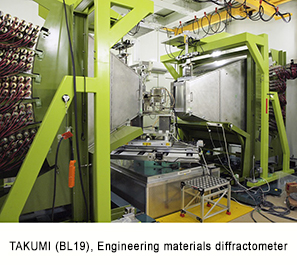 
 * Click here to enlarge. * Click here to enlarge. |
| The "KUMADAI" magnesium alloy developed by Professor Yoshihito Kawamura and colleagues from the Magnesium Research Center, Kumamoto University, has higher strength and greater ductility than previous magnesium alloy materials, and there are high expectations for practical applications in industry as a next-generation lightweight structural material. However, this alloy has a special structure called a "Synchronized Long-Period Ordered Structure (LPSO) ", and although it was known that this contributes to physical characteristics such as high strength and ductility, the details of the mechanism were not understood. |
| Thus an attempt has been made to elucidate the strength improvement mechanism by using BL19 (TAKUMI) of the MLF to observe internal strain produced when force is applied to this magnesium alloy. As a result, it was found that, in the case of this magnesium alloy-whose structure has this special atomic arrangement-strain of the atomic arrangement is retained and not released in response to stress. This is the first experimental confirmation that it functions as a "strengthening phase" which ensures retention of strength. |
| TAKUMI (BL19) has the highest resolution among engineering material diffractometers. In addition to measuring stress, it is an extremely powerful instrument for conducting measurement of phase transitions and aggregate structures, and for research in areas such as anisotropy of deformation. Going forward, when the output of the neutron source of J-PARC reaches 1 MW, it will become possible to conduct experiments requiring measurement over short time intervals, such as in-situ observation of material manufacturing processes, and it is expected that this will be useful not only for materials science, but also for research on improving technology to maintain safety in our daily lives. |
| ĀúReceived Encouragement Prize at 14th Annual Meeting of the Japanese Society for Neutron Science (December 11-13) |
|---|
| This annual meeting was held at Hokkaido University, and at the society's awards ceremony on the 11th, Encouragement Prizes were awarded to Dr. Norifumi Yamada of J-PARC's Neutron Science Section, and Dr. Hiroshi Nakagawa of the JAEA's Quantum Beam Research Center and J-PARC's Neutron Science Section. This prize is presented to younger members to recognize achievements such as outstanding research publications relating to the development of neutron science. |
| Dr. Yamada led the development of a neutron reflectometer integrated into SOFIA (BL16) in J-PARC's MLF, and the start-up of the new SOFIA. In this way, he has moved forward efforts such as development of an environment, including development of a softwear for data analysis, where high-quality experimental research can be carried out. Dr. Nakagawa used AMATERAS (BL14) to elucidate conditions where the functions of proteins manifest themselves, and changes in dynamics (dynamic function) dependent on the DNA sequence. |
| < Research themes recognized by these awards > |
| Dr. Norifumi Yamada, |
"Development of neutron reflectometer with horizontal-sample geometry, SOFIA, at J-PARC" |
| Dr. Hiroshi Nakagawa, |
"Research on the hydration and dynamics of biomolecules through incoherent scattering of neutrons and molecule simulation" |
|
| ĀúSituational Emergency Training at J-PARC (November 25) |
|---|
| Working jointly with the JAEA and KEK, the J-PARC Center carried out integrated emergency reponce training for a situation, assuming a scenario of target damage like the accident which occurred in May of last year at the Hadron Experimental Facility. This training was open to Ibaraki Prefecture, six neighboring municipalities, and the media. During the training, a teleconferencing system was used as the primary means of communication in order to speed up transfer of information between the command post at the accident site, the on-site response headquarters, the JAEA and KEK. |
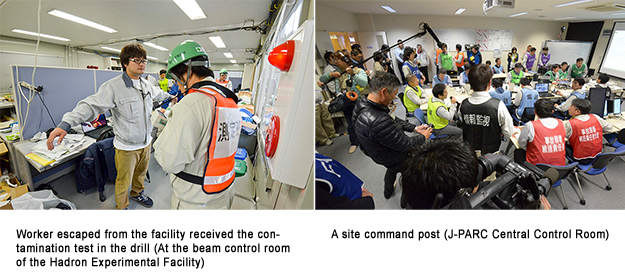
 * Click here to enlarge. * Click here to enlarge. |
| |
| Ā£to Page Top |
| |
| ĀúSafety Check of the Hadron Experimental Facility with Third Party Inspection Support (December 3) |
|---|
| Previously, the J-PARC Center has repaired facilities in accordance with measures to prevent accident recurrence. As a further step, a safety check of facilities and other areas was recently conducted with the support of the Nuclear Safety Technology Center. The situation was investigated, at the 50GeV synchrotron, by checking operation of the beam extraction quadrupole (EQ) power supply where accident countermeasures have been taken, and, at the the Hadron Experimental Facility, by inspecting repair work carried out to prevent accident recurrence. |
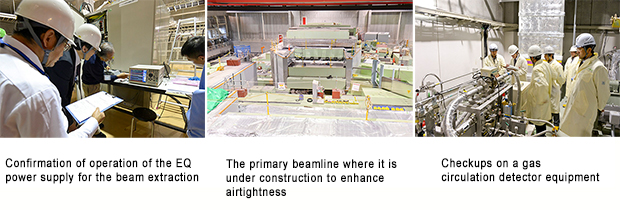
 * Click here to enlarge. * Click here to enlarge. |
| |
| Ā£to Page Top |
| |
|
| (1) At the 50GeV synchrotron (MR) , a septum magnet is being developed for beam extraction from the circulating path. (2) At the Materials and Life Science Experimental Facility (MLF) , a BL22 (RADEN) assembly building is being constructed on the western side of MLF. (3) At the Hadron Experimental Facility (HD) , gas circulation detector equipment and other systems have been installed as part of the facility repair. |
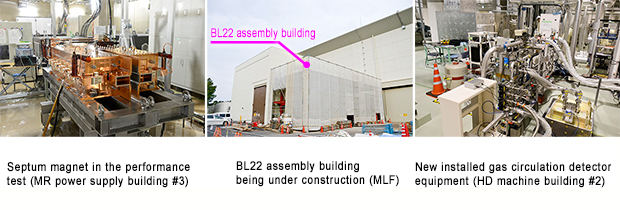
 * Click here to enlarge. * Click here to enlarge. |
| |
| Ā£to Page Top |
| |
|
| ĀúMLF School 2014 (December 16-19) |
|---|
| The 2nd MLF School for experiencing neutron and muon experiments was held at the MLF. It was for graduate students, young researchers and others who are new to the MLF and interested in its experiments, and there were 22 participants, whereas we had 24 participants for the 1st school in 2012. |
| An entrance ceremony, orientation, safety training and other events were held on the first day. For the first half of the second day, participants attended lectures by the instructors on physical property experiments. On the second half and the third day, the participants were divided into eight practical courses (inelastic scattering by neutrons, reflectance, powder diffraction, small-angle scattering, single-crystal diffraction, engineering diffraction experiments, and muon experiments). With guidance from the staff in charge of each instrument, the students received hands-on training for tasks such as sample preparation, mounting samples in the instruments, obtaining data by actually exposing the sample to neutrons and muons, and analyzing the results. On the final day, there were presentations on the results of practical work in each group, and here too there was lively discussion. At this school, there were participants from overseas for the first time, and in future schools there are expected to be participants from various countries, not only Japan. |
 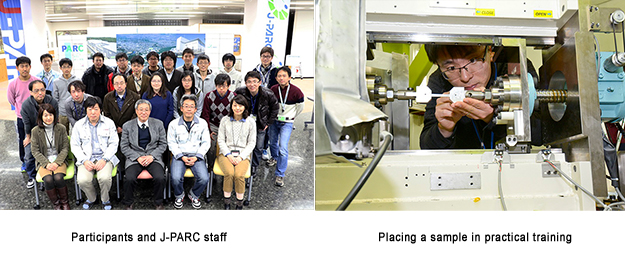
 * Click here to enlarge. * Click here to enlarge. |
| |
| Ā£to Page Top |
| |
|
| ĀúHello Science School (December 15) |
|---|
| A science experiment school was held jointly with Tokai Village for junior high school students in the local area. J-PARC public relations advisor, Dr. Shinichi Sakamoto, acted as the instructor. He gave an easy-to-understand explanation of topics such as the principle of operation of the huge accelerator research instrument, while using experimental equipment constructed from familiar materials. This was an effort to inspire interest in science among the children, and the first follow-up project of the "science summer school" led by scientists during the summer vacation. |
  |
| |
| Ā£to Page Top |
| |
|
©2015 J-PARC Center. All rights reserved.
|
|